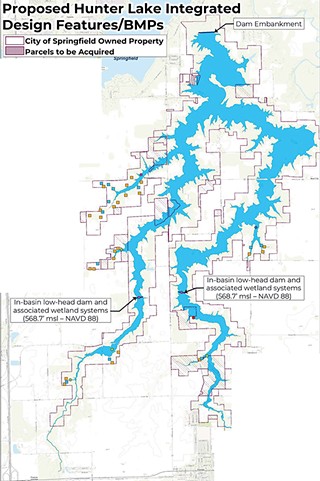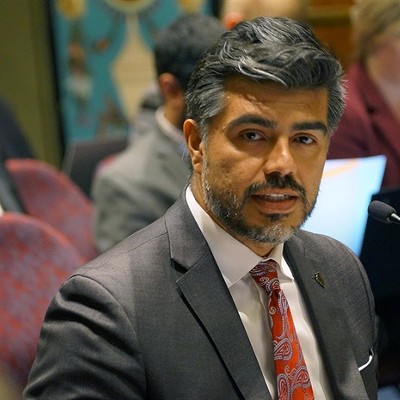Springfield officials are pushing back against assertions that the U.S. Environmental Protection Agency has dealt a blow to a proposed second lake for the city's future water needs.
Don Hanrahan, a lawyer and rural Springfield resident, told Illinois Times the EPA's latest recommendation that the U.S. Army Corps of Engineers deny a permit for construction of City Water, Light and Power's proposed Hunter Lake is "a significant black eye" for the municipally owned utility.
Hanrahan, political chairperson of the Sangamon Valley Group in the Sierra Club's Illinois chapter, said, "It feels really nice that somebody with big guns is finally saying what we've been saying for the past 30 years: There's no need for this lake."
In addition, he said the recommendation is a "very significant signal" to the Illinois EPA, which eventually would be called upon to issue its own permit for Hunter Lake, that the proposal "can't pass muster."
But CWLP officials said it's wrong to interpret the EPA's recommendation as a setback in CWLP's quest for regulatory approval at the federal and state level to build Hunter Lake and help the city deal with future droughts.
The U.S. EPA recommendation was one of more than 400 comments submitted to the Army Corps during a 45-day public comment period that ended Sept. 25 as part of the federal agency's effort to draft a final Supplemental Environmental Impact Statement on the plan, according to Todd LaFountain, CWLP water division manager.
The U.S. EPA's comments were "really not a lot different" than what the agency has said in response to the earlier proposals from the city for a water source to supplement Lake Springfield, LaFountain said.
EPA officials believe "there were a few things that needed to be expanded upon" in Springfield's proposal, he said. The Army Corps will research those issues, and federal regulators may seek more information from the city before a final impact statement is issued, possibly by summer 2024, he said.
The Corps' decision on a permit would come sometime after the impact statement is issued.
CWLP spokesperson Amber Sabin said the EPA's observations are "not new."
However, Hanrahan said the EPA's latest statements were more explicit in outlining the city's challenges in satisfying applicable state and federal laws to build the $153 million lake. Hunter Lake would be created on 2,600 acres east of Lake Springfield's 4,300 acres and north of Pawnee.
Allen Marshall, a spokesperson for the Army Corps' office in Rock Island, wouldn't comment on Hanrahan's characterization of the EPA recommendation and its impact on the future outcome of Springfield's application.
"Everything is still ongoing," he said. "The permit application is under evaluation."
Springfield officials have discussed a potential second lake for the city since the early 1950s. The city's formal efforts to obtain a permit from the Army Corps began in 1989.
If regulatory hurdles are cleared, the Springfield City Council would need to make a final decision on whether to proceed and how to pay for the project and a second lake's future ongoing operations. CWLP likely would finance the project through increases in water rates that are among the lowest in the state.
Hunter Lake opponents obtained a copy of the U.S. EPA recommendation through an Illinois Freedom of Information Act request to the Illinois Department of Natural Resources. The EPA sent a copy to IDNR when it submitted its recommendation in September as a public comment to the Army Corps.
EPA Wetlands and Watersheds Branch Manager David Pfeifer wrote in the 11-page document that the project, as proposed, "does not comply with" Clean Water Act guidelines.
"Specific deficiencies in the application include the project purpose and need, alternative analysis, water quality impacts to impaired waterways, and the proposed compensatory mitigation," Pfeifer wrote.
"We recommend that the Corps not issue a permit for the project as proposed unless the noted deficiencies are addressed, and the information provided by the applicant is compliant with the guidelines," he said.
The document said Lake Springfield is the source of Springfield's domestic water supply and provides drinking water to about 147,750 people who use an average of 22 million gallons of water each day.
According to the city's application, Springfield needs a secondary water source because the city's projections show that the city's water demand in 42 years could be as high as 33.62 million gallons per day. Springfield officials told the Corps that Hunter Lake would hold more than 12 billion gallons of water and meet the potential need.
But the EPA noted that a water demand analysis completed in 2015 and 2016 showed the "potable and industrial water use demand" in Springfield would decline from 2012 to 2020, and the city's population has been declining since 2010.
Despite this data, Pfeifer wrote that the city predicts population growth "in the long term without a detailed explanation."
He added: "The EPA recommends that the applicant use real-time data to justify this projected increase in potable and industrial water demand. If Springfield's population is expected to decrease, the need for the project may no longer be imminent."
Dean Olsen is a senior staff writer at Illinois Times. He can be reached at [email protected], 217-679-7810 or twitter.com/DeanOlsenIT.





















